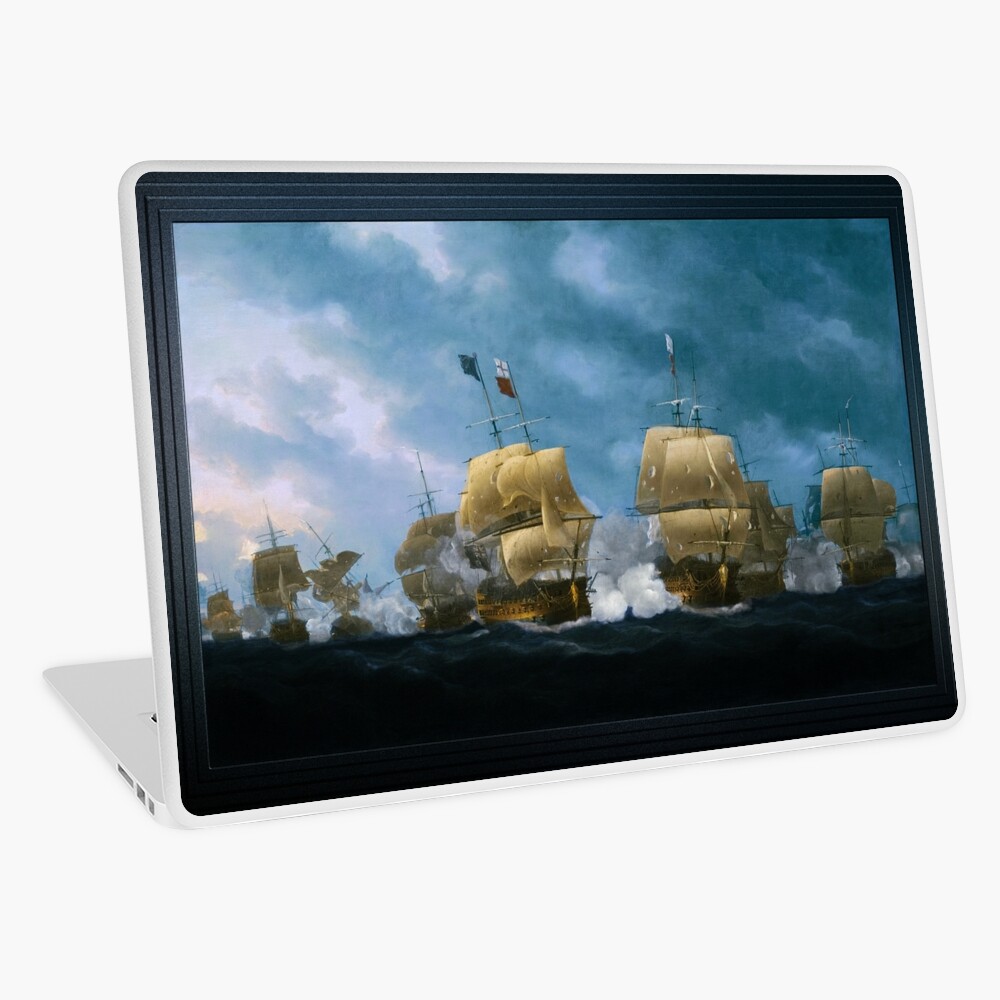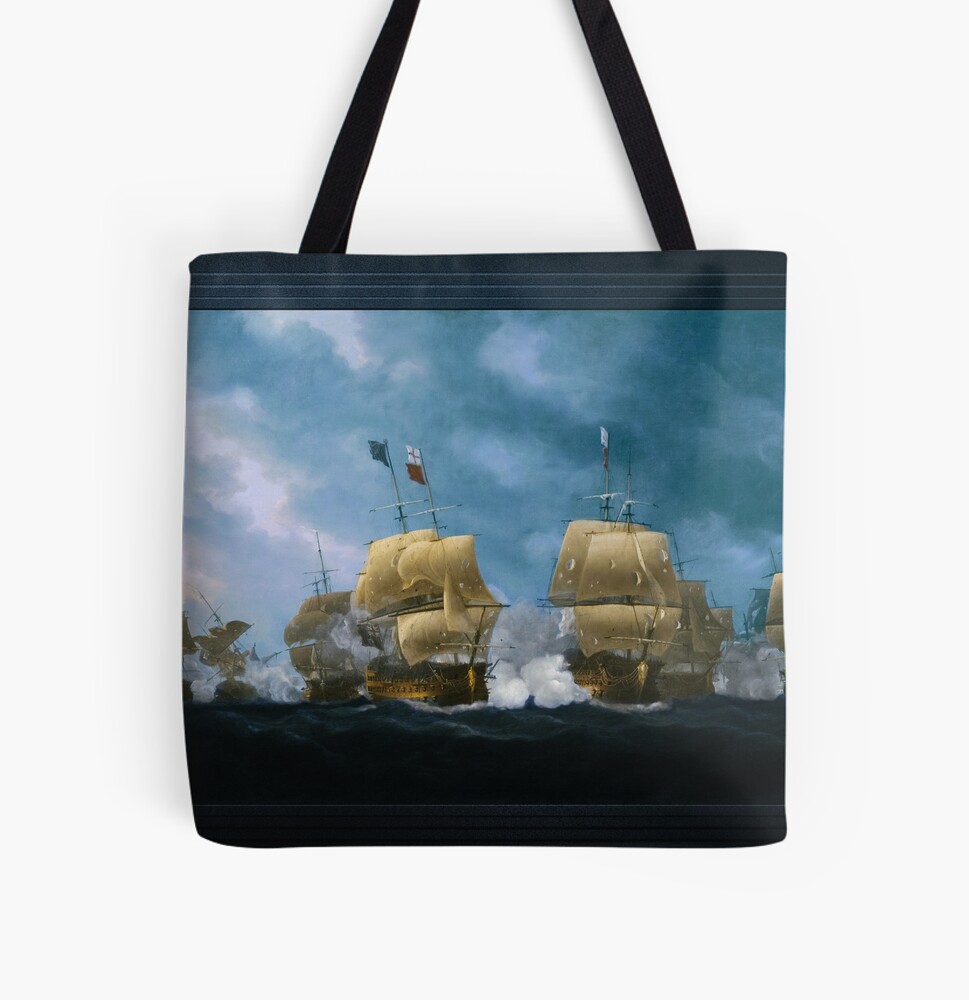
The Battle of Quiberon Bay
The Battle of Quiberon Bay, پر 20 نومبر۔ 1759 by British Painter Nicholas Pocock (1740 – 1821); is known for the numerous naval battle scenes he created during the age of the sailing ships

The sea Battle of Quiberon Bay is powerfully portrayed in this painting by British Painter Nicholas Pocock, as a fleet of warships under take a war at sea, engaging each other at close quarters, firing there canons into the bowels of each others warships on the rough going high seas, beneath storm clouds on a heavily overcast day.
The Battle of Quiberon Bay is a retouched digital art old masters reproduction of a public domain image that is available for purchase online in a variety of material formats including canvas prints, ایکریلک پرنٹس, دھاتی پرنٹس, لکڑی کے پرنٹس, فریم شدہ پرنٹس, پوسٹرز, اور کے طور پر رولڈ کینوس پرنٹس سے سائز کی ایک قسم میں 12 انچ تک 72 انچ اصل آرٹ ورک کے سائز اور پرنٹ آن ڈیمانڈ شاپ پر منحصر ہے جس سے آپ آرٹ خریدنے کا انتخاب کرتے ہیں.
نیچے سے حاصل کردہ معلومات۔ Royal Museums Greenwich
The Battle of Quiberon Bay was a major naval engagement that took place on November 20, 1759, during the Seven Years War. The conflict involved the major European colonial powers and was fought around the globe. The French had been at war with Britain since 1756, and their position in Canada, ہندوستان, and the West Indies was on the verge of collapse. In Europe, they faced stalemate against Prussia, which received British support.

The French planned to land an army of 20,000 men in Ireland, which was assembled in the gulf of Morbihan in southern Brittany under the Duc d’Aiguillon. The force was to be escorted by the Brest fleet under Admiral Hubert de Conflans. Admiral Sir Edward Hawke’s Channel Fleet blockaded Brest to prevent the French from leaving to collect the troop transports. البتہ, during a gale in the first week of November, Hawke’s ships were forced to run for shelter in Torbay, giving de Conflans the chance to escape.
On hearing that the French had escaped, Hawke pursued them and sighted them 20 miles out to sea on November 20. De Conflans, relying on local knowledge, ordered his fleet to take refuge in Quiberon Bay, south of Morbihan, assuming Hawke would not follow due to the ill-charted rocks, reefs, and wild seas. This was a miscalculation, and Hawke relentlessly pursued him into the bay, losing two of his own ships on the outer reefs but sinking the French ‘Thesee’ and ‘Superbe’ by a combination of gunfire and the weather, and otherwise decimating de Conflans’ force in what became an action practically in the dark.

The French flagship ‘Soleil Royal’ went aground in the bay, near Le Croisic, and was burned to prevent capture the following day. Others were captured, including the ‘Heros,’ which was burned. A few French ships escaped to Rochefort, and some others managed to find refuge in the mouth of the River Vilaine, where they were trapped for months, and one more lost by grounding.
The battle was a decisive victory for the British, and it stopped any French plans to invade Britain during the Seven Years War. The famous naval song ‘Hearts of Oak’ was composed to commemorate the battle. The battle was fought so close inshore that contemporary accounts reported that ten thousand persons watched it from the coast.
This rather later painting by Pocock is partly based on an earlier one by Dominic Serres and shows Hawke’s ‘Royal George’ in the left center, with his blue admiral’s color at the main, in action with de Conflans’ ‘Soleil Royal’ to the right, though the latter is wrongly shown as a three-decker. A French ship astern of the ‘Royal George’ is firing broadsides on both sides, her starboard battery probably directed at Augustus Keppel’s ‘Torbay,’ while between them, the French ‘Thesee’ sinks by the bows.
This was largely due to water swamping through her lower and forward leeward gunports in the heavy seas, since this battle was an example of the disadvantage of fighting with the ‘weather gauge’ (the generally assumed benefit of being to windward).
سے اخذ کردہ معلومات Wikipedia.org

پوکاک برسٹل میں پیدا ہوا تھا۔ 1740; ایک بحری جہاز کا بیٹا, اس نے اپنے والد کے پیشے پر عمل کیا اور اس کی عمر تک ایک تجارتی جہاز کا ماسٹر تھا۔ 26.
سمندر میں اپنے وقت کے دوران۔, وہ اپنی لاگ بکس کے لیے جہازوں اور ساحلی مناظر کی سیاہی اور دھونے کے خاکے بنا کر ایک ماہر فنکار بن گیا۔.
میں 1778, پوکاک کا آجر۔, رچرڈ چیمپئن۔, ٹرانس اٹلانٹک تجارت پر امریکی انقلابی جنگ کے اثرات کی وجہ سے مالی طور پر دیوالیہ ہو گیا۔.
اس کے نتیجے میں, پوک نے سمندر کو چھوڑ دیا اور اپنے آپ کو پینٹنگ کے لیے وقف کر دیا۔; برٹش رائل اکیڈمی آف آرٹس کی طرف سے ان کے پہلے کاموں کی نمائش 1782.
اس سال کے آخر میں۔, پوکاک کو پینٹنگز کی ایک سیریز تیار کرنے کا کام سونپا گیا تھا جس میں جارج روڈنی کی جنگ سنتوں کی فتح کی عکاسی کی گئی تھی; اور سموئیل ہوڈ کے پسندیدہ کے طور پر اسے کنگ جارج کا میرین پینٹر مقرر کیا گیا۔.
پوکاک کی بحری پینٹنگز میں وسیع تحقیق شامل ہے۔, موسم اور ہوا کے حالات کے ساتھ ساتھ پوزیشنوں کے بارے میں عینی شاہدین کے انٹرویو بھی شامل ہیں۔, حالت, اور ان کے جہازوں کی ظاہری شکل; اور جنگ کے تفصیلی منصوبے اور انفرادی جہازوں کے ابتدائی خاکے بنانا۔.
وہ اپنے آپ کو جون کے شاندار اول میں بھی موجود تھا۔ 1794, فریگیٹ ایچ ایم ایس پیگاسس پر سوار۔. اس کے بڑے پیمانے پر آئل پینٹنگز کے علاوہ بحری لڑائیوں کو بھی دکھایا گیا ہے۔, پوکاک نے ساحلی اور جہاز کے مناظر کے بہت سے آبی رنگ بھی تیار کیے۔.



